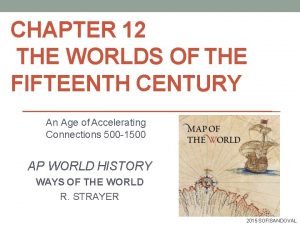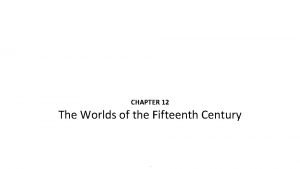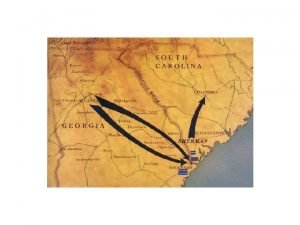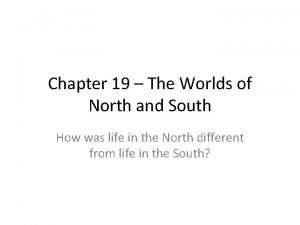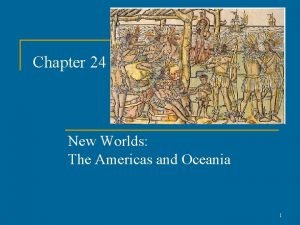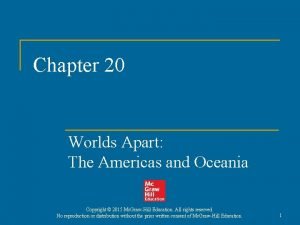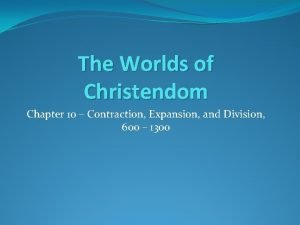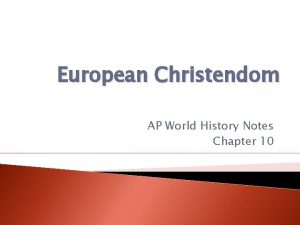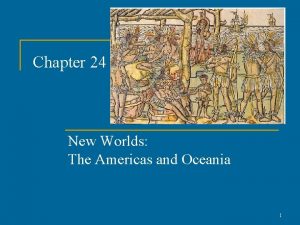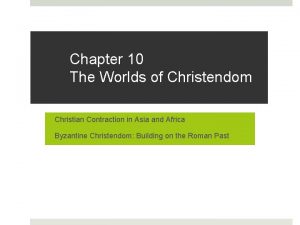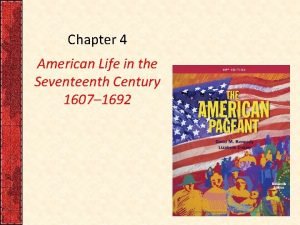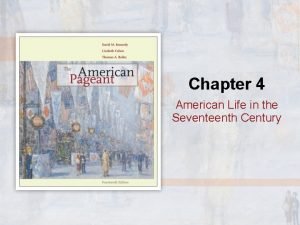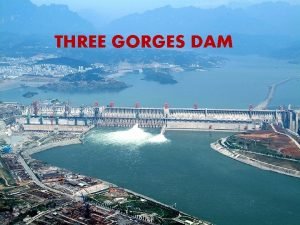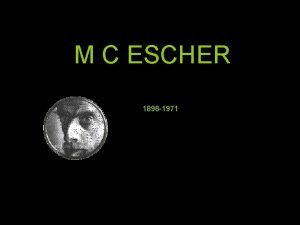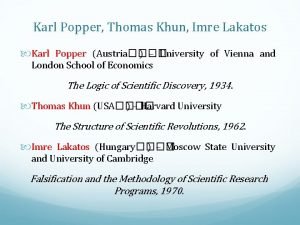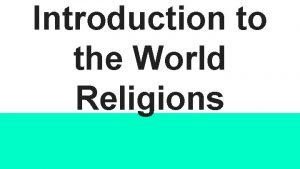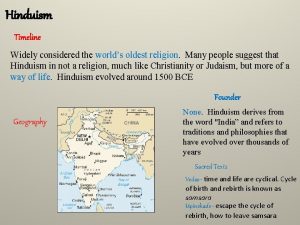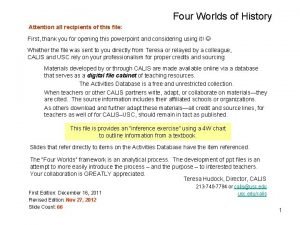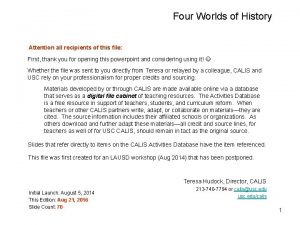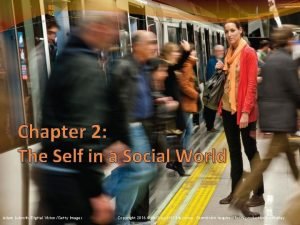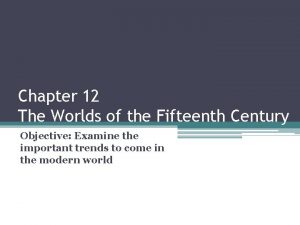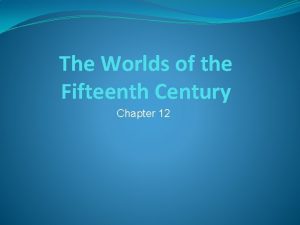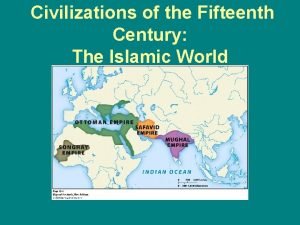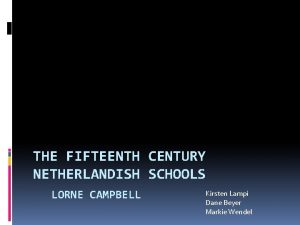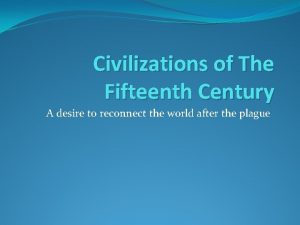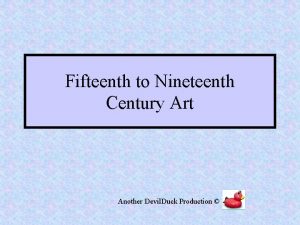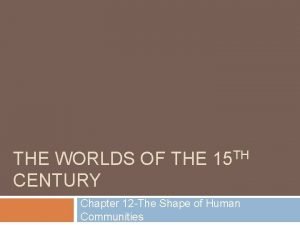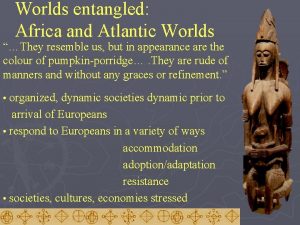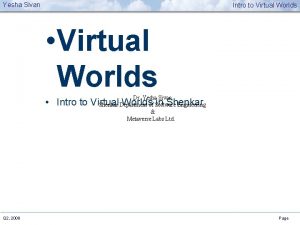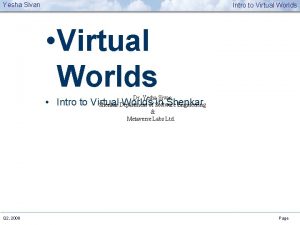CHAPTER 12 The Worlds of the Fifteenth Century









































- Slides: 41

CHAPTER 12 The Worlds of the Fifteenth Century .


I. The Shapes of Human Communities A. Paleolithic Persistence: Australia and North America 1. Gatherers and hunters have a history, too a. While non-literate and non-urban, these societies did change over time; we just don’t have written records of it. 2. Manipulation of the environment and trade a. In Australia, aboriginal peoples manipulated the environment and engaged in relatively long-distance trade networks, indicating a certain degree of complexity. 3. “Complex” or “affluent” gatherers and hunters a. In the Pacific Northwest, the abundance of food sources allowed for permanent settlements of large houses, social stratification and complexity, and extensive food storage.

I. The Shape of Human Communities B. Agricultural Village Societies: The Igbo and the Iroquois 1. Egalitarian kinship societies without state systems a. These societies had histories and a certain degree of social and economic sophistication, but they did not have larger political systems. Instead they relied on kinship. 2. “The Igbo have no king” but they did trade a. The West African Igbo of present day Nigeria did not have kings or a state like their neighbors, but they did engage in trade with nearby kingdoms. 3. Great Law of Peace of the Five Nations a. In what is now central New York state, history developed in a complex manner. With a major agricultural shift, the Iroquois-speaking people became more productive and populations grew. The growing populations created conflict and frequent warfare until sometime in the fifteenth century when an alliance was formed and a truce established. This Great Law of Peace put an end to the bloodshed and allowed the development of limited government, social equality, and personal freedom.

I. The Shape of Human Communities C. Pastoral Peoples: Central Asia and West Africa 1. Timur/Tamerlame (d. 1405) a. This was the last great Central Asian leader of warrior nomads. His armies attacked and plundered parts of Russia, Persia, and India, but he died before invading China. His descendants maintained control of an important central asian region. Yet in the coming centuries, most of the Turkic nomads would face imperial expansion from Russia and China. 2. Samarkand a. This was the most important city of the Timur’s descendants. Here Persian and Turkic cultures blended in a sophisticated elite culture. 3. Fulbe a. These people from the upper reaches of the Senegal River were nomadic cattle herders who traveled among settled societies. While they paid rent to these settled community for grazing rights, they held the farmers’ way of life in contempt. Later they would convert to Islam, lead a series of jihads, and establish their own states.


II. Civilizations of the Fifteenth Century: Comparing China and Europe A. Ming Dynasty China 1. Emperor Yongle (r. 1402– 1422) a. This emperor sponsored a number of important projects to get China back on track after the Mongols, including public works, building a new capital complete with new temples and courts, overseas missions, and the writing of an enormous Encyclopedia. 2. Confucianism and anti-Mongol policies a. In a move to wipe out the Mongol legacy and rebuild the Chinese state system, Yongle and others promoted Confucianism and the exam system as a form of re-sinicizing China.

II. Civilizations of the Fifteenth Century: Comparing China and Europe 3. Economic boom a. As the Ming repaired infrastructure and fields damaged by the Mongols, the state set in motion substantial economic growth 4. Zheng He’s voyages (1405– 1433) a. One of the most remarkable moments in the Ming Dynasty were the massive fleets sponsored by Yongle and commanded by Admiral Zheng He. For several decades, hundreds of ships with 27, 000 men sailed the China seas and the Indian Ocean, demonstrating Chinese power. However, this was not a mission to colonize or conqueror, but rather a trade mission that encouraged the expansion of the tribute state system. The fleet was suddenly recalled and scuttled in the 1430 s, and the Ming turned away from sending merchants out to the world and, instead, let the world come to China.




II. Civilizations of the Fifteenth Century: Comparing China and Europe B. European Comparisons: State Building and Cultural Renewal 1. Smaller states in constant conflict a. In contrast to China, Europe was a region divided into many smaller states that were in near constant conflict with each other. The Hundred Years’ War (1337– 1453) between France and England serves as an example. 2. Renaissance humanism a. Starting in northern Italy, the Renaissance was a revival of Greco-Roman art and philosophy. By focusing on the achievements of individuals and on real-world practicalities, the ideology of the Renaissance, humanism, was a direct challenge to the other worldly spiritualism of the church.

II. Civilizations of the Fifteenth Century: Comparing China and Europe C. European Comparisons: Maritime Voyaging 1. Portugal takes the lead after 1415 a. The Portuguese state, with support of the pope, launched a series of voyages that culminated in Vasco da Gama leaving Portugal for India in 1497. Columbus, sailing for Portugal’s rival Spain, reached the Americas in 1492. 2. Smaller ships and fleets than the Chinese a. The most obvious contrast between the two maritime forces was the size of the ships and the fleets. While Zheng He had hundreds of ships and 27, 000 men, the Iberians sent out a handful of ships with crews around one hundred. This showed a dramatic difference in power and wealth.

II. Civilizations of the Fifteenth Century: Comparing China and Europe 3. Motives, goals, and support: a. As China was wealthy, it had no real need to expand overseas, and as China was centralized, when the state decided to stop the voyages, it could do so very quickly. The Europeans, on the other hand, were desperate to break into the larger world economy. As Europe was divided into a number of competing states, almost all of whom were in competition with the Islamic world, there was a sense that if a state did not take to the seas, it would lose out to its rivals. In Europe, merchants saw economic opportunities, monarchs saw new tax revenues, and the church saw a way to expand the faith. Thus, there were many more push factors in the poorer and isolated Europe than there were in the wealthy and confident China.




III. Civilizations of the Fifteenth Century: The Islamic World A. In the Islamic Heartland: The Ottoman and Safavid Empires 1. Ottoman size, strength, and longevity a. The Ottoman Empire is one of the great empires in world history. Its scale, power, and age, as well as its cultural achievements, place it in the same category as China. 2. 1453: Turkish threat to Europe a. While the Crusades marked a period where Christendom was on the offensive against Islam, the Turks built a massive military that ended the Byzantine Empire in 1453 with the taking of Constantinople, making them the heirs to Rome. The Ottoman Turks would then lead a series of military campaigns into Europe, laying siege to Vienna in 1529.

III. Civilizations of the Fifteenth Century: The Islamic World 3. Shia Safavids versus Sunni Ottomans a. After 1500, the Safavids emerged as a rival to the Ottomans. Based in Persia, they promoted the Shia branch of Islam and thus fueled a sectarian conflict with the Sunni Ottomans.



III. Civilizations of the Fifteenth Century: The Islamic World B. On the Frontiers of Islam: The Songhay and Mughal Empires 1. Islam and the trans-Sahara trade a. Islam came to West Africa via the trans-Sahara trade. The Songhay Empire was an Islamic successor to previous empires in the region. On the edge of the Muslim world, the Songhay spread Islam but also blended African traditions into their practice and culture. 2. Political unity and religious diversity in India a. The Mughals brought a rare moment of political unity to India. Ruling over a mostly Hindu population, they were initially very tolerant of non-Muslims and created a diverse and vibrant cultural world.

III. Civilizations of the Fifteenth Century: The Islamic World 3. Muslim merchants and Sufi mystics in Southeast Asia a. The Muslims empires promoted both the expansion of trade and the faith by sending merchants into Southeast Asia and on to China. Sufi mystics helped to spread Islam in maritime Southeast Asia. 4. Malacca a. Sitting at one of the key trade routes in the world, Malacca was an Islamic city-state that became famously wealthy and cosmopolitan thanks to its access to trade and by providing safe and reliable port facilities.


IV. Civilizations of the Fifteenth Century: The Americas A. The Aztec Empire 1. Mexica a. This tribe from present day northern Mexico settled on an island in Lake Texcoco by 1325. Over the next century, they built up their power by military service, alliances, and constructing a massive city. Later, they claimed descent from the more prestigious line of the Toltecs and Teotihuacán. 2. Tenochtitlán a. The Aztec capital was a large city of up to 200, 000 inhabitants. Set on an island in the middle of a lake, it had canals, causeways, markets, and floating gardens. When the Spanish arrived in 1519, they were stunned by the city’s sophistication and acknowledged that it was far superior to anything in Spain.

IV. Civilizations of the Fifteenth Century: The Americas 3. Conquest state and market centers a. The Aztec Empire was a conquest-based state that required tribute from its conquered subjects. Tribute came in the form of goods for the markets, elite luxury items, and human slaves. 4. Tlacaelel (1398 -1480) and ideology of human sacrifice a. Human sacrifice was common in Mesoamerican history, but the Aztecs took it to a new level. The prominent official Tlacaelel promoted the idea that the god Huitzilopochtli needed human blood to rebuild his strength for his constant struggle with the forces of darkness. Massive ritual sacrifices also performed a political function and impressed the enemies of the Aztecs.



IV. Civilizations of the Fifteenth Century: The Americas B. The Inca Empire 1. 2, 500 miles and 10, 000 subjects a. The Inca were similar to the Aztec in that they were a small marginal group that came to rule a large empire and used previous precedents to justify their rule, but the Inca had a much larger territory than the Aztec. 2. State bureaucracy, resettlement, and Quechua a. The Inca had a much more developed and invasive state bureaucracy than the Aztecs, who generally left their people alone. The Inca resettled large numbers of conquered people and encouraged the use of Quechua as a language.

IV. Civilizations of the Fifteenth Century: The Americas 3. Mita a. The Inca did not require human tribute for sacrifice as the Aztecs did, but they did require a work tax known as mita. Some women were taken from their homes, raised as elites, and married to Incan officials. 4. Gender parallelism but not gender equality a. While the Incan system was not equal for the sexes, each had their own spheres in a parallel structure. The tasks of each gender were valued


V. Webs of Connection 1. Empires a. The great empires of the fifteenth century linked diverse people across long distances. The Inca were particularly noteworthy for integrating people into their culture. 2. Religion a. Islam and Buddhism forged international linkages. 3. Long-established and long-distance trade a. As trade links developed over many centuries, they were particularly extensive by the fifteenth century and could deliver commodities from one ecosystem to another. 4. Increase in maritime trade a. Improved and larger ships promoted more trade by the seas, especially in the Indian Ocean and Southeast Asia.


VI. A Preview of Coming Attractions: Looking Ahead to the Modern Era, 1500– 2012 1. Extensive trade but not yet truly global a. While the trade networks ran deep and were quite large, the globe was not yet connected 2. Coming linkage of Afro-Eurasia, the Americas, and Oceania a. Soon the whole world would become linked in what is now an almost inescapable global system.

VI. A Preview of Coming Attractions: Looking Ahead to the Modern Era, 1500– 2012 3. Radical change with industrialization a. European technological advances would change methods of production, styles of living, and the ability to project power after the nineteenth century. 4. Demographic explosion a. Human population would grow exponentially and impact other species on the planet like never before.

VI. A Preview of Coming Attractions: Looking Ahead to the Modern Era, 1500– 2012 5. Urbanized, commercialized, and literate a. Cities would get larger and more common, people would be more tied into for-profit methods of production, and literacy would spread and open new perspectives on the world. 6. Revolution of modernity a. All of these forces made the second great revolution since the Agricultural Revolution, the revolution of modernity. 7. Rise of Europe and resistance to Europe a. The modern era saw the unprecedented rise of Europe and the expansion of Europeans. The rest of the world had to decide how to deal with them. Often resistance came to characterize this process.





 Chapter 12 worlds of the 15th century
Chapter 12 worlds of the 15th century The worlds of the fifteenth century
The worlds of the fifteenth century Norton worlds together worlds apart
Norton worlds together worlds apart 12 course french classical menu ppt
12 course french classical menu ppt Human resource management fifteenth edition
Human resource management fifteenth edition Human resource management lecture chapter 1
Human resource management lecture chapter 1 University physics with modern physics fifteenth edition
University physics with modern physics fifteenth edition Fifteenth amendment
Fifteenth amendment Chapter 19 the worlds of north and south
Chapter 19 the worlds of north and south Chapter 24 new worlds the americas and oceania
Chapter 24 new worlds the americas and oceania Chapter 24 new worlds the americas and oceania
Chapter 24 new worlds the americas and oceania Chapter 20 worlds apart the americas and oceania
Chapter 20 worlds apart the americas and oceania Chapter 10 the worlds of christendom notes
Chapter 10 the worlds of christendom notes Chapter 10 ap world history
Chapter 10 ap world history Chapter 24 new worlds the americas and oceania
Chapter 24 new worlds the americas and oceania The worlds of christendom
The worlds of christendom Chapter 1 three worlds meet answer key
Chapter 1 three worlds meet answer key Chapter 4 american life in the seventeenth century
Chapter 4 american life in the seventeenth century American life in the seventeenth century
American life in the seventeenth century 8-5 challenge problem accounting answers
8-5 challenge problem accounting answers 1. 5-1 work together, p. 128
1. 5-1 work together, p. 128 Chapter 4 american life in the seventeenth century
Chapter 4 american life in the seventeenth century Chapter 4 american life in the seventeenth century
Chapter 4 american life in the seventeenth century World's largest combustion engine
World's largest combustion engine Debate team roles
Debate team roles Figured worlds theory
Figured worlds theory Three gorges dam spillway
Three gorges dam spillway Number worlds level c
Number worlds level c M.c. escher castrovalva (1930)
M.c. escher castrovalva (1930) The world's smallest continent
The world's smallest continent Karl popper theory
Karl popper theory Religion
Religion Internet is world's largest
Internet is world's largest Whats the oldest religion
Whats the oldest religion 4 worlds of history
4 worlds of history Four worlds of history
Four worlds of history 4 worlds chart
4 worlds chart Is travel the largest industry in the world
Is travel the largest industry in the world These are mental templates by which we organize our worlds.
These are mental templates by which we organize our worlds. Active worlds
Active worlds The world's oldest democracy
The world's oldest democracy What is the history of keyboard
What is the history of keyboard
